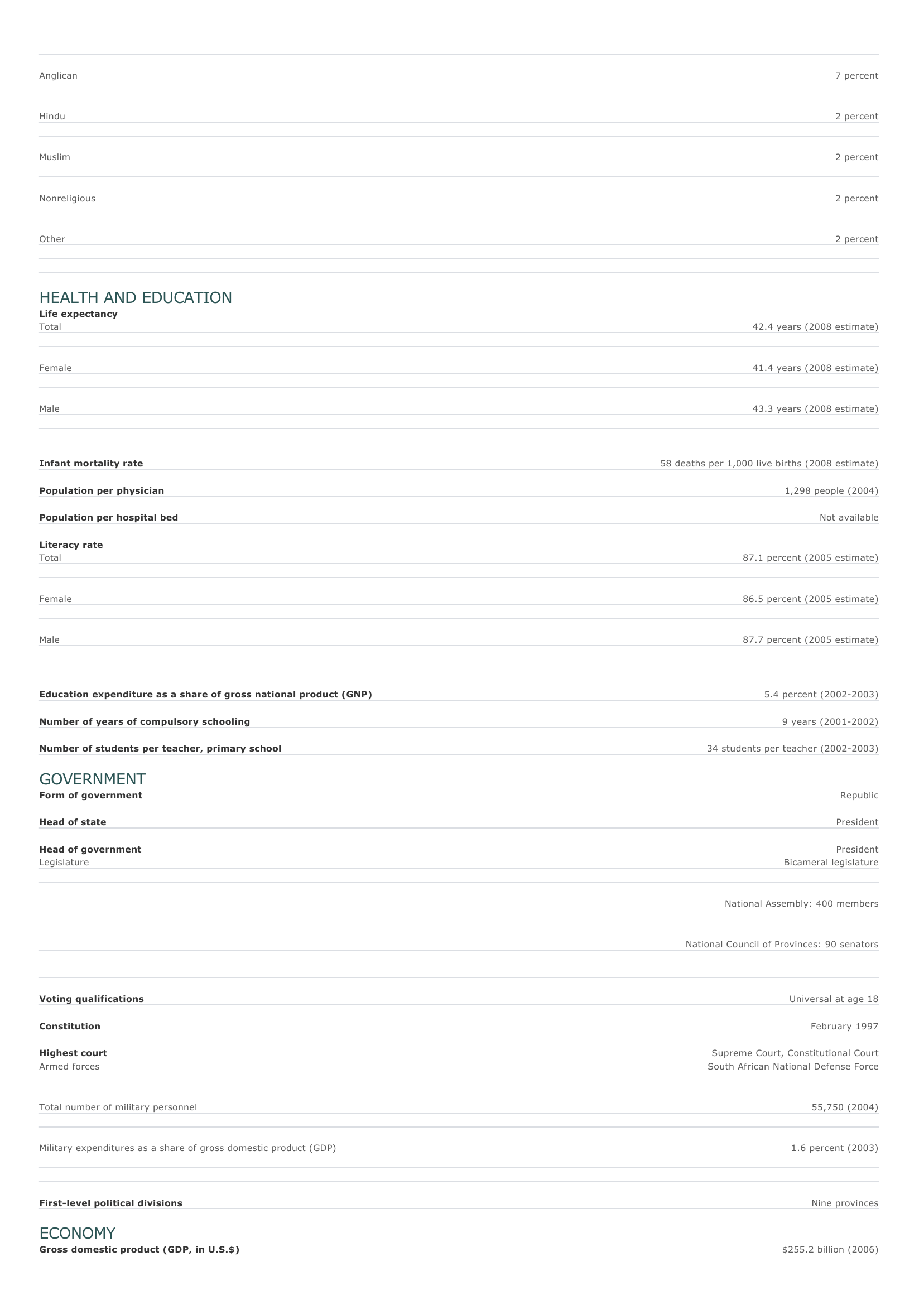South Africa Facts and Figures. BASIC FACTS Official name Republic of South Africa Capital Pretoria (administrative); Cape Town (legislative); Bloemfontein (judicial) Area 1,219,090 sq km 470,693 sq mi PEOPLE Population Population growth Population growth rate 43,786,115 (2008 estimate) -0.50 percent (2008 estimate) Projected population in 2025 39,905,523 (2025 estimate) Projected population in 2050 33,002,952 (2050 estimate) Population density 36 persons per sq km (2008 estimate) 93 persons per sq mi (2008 estimate) Urban/rural distribution Share urban 58 percent (2005 estimate) Share rural 42 percent (2005 estimate) Largest cities, with population Johannesburg 3,225,796 (2001) Durban 3,090,122 (2001) Cape Town 2,967,000 (2003 estimate) Pretoria 1,209,000 (2003 estimate) Port Elizabeth 1,005,779 (2001) Ethnic groups Africans/Black 77 percent White 11 percent Coloureds/mixed race 9 percent Indians/Asians 2 percent Others 1 percent Languages 11 official languages: Afrikaans and English (European origin); Zulu, Xhosa, siSwati, and Ndebele (Nguni language group); Southern Sotho, Northern Sotho, and Tswana (Sotho language group); Tsonga; Venda Religious affiliations Black Independent Churches 46 percent Protestant 31 percent Roman Catholic 8 percent Anglican 7 percent Hindu 2 percent Muslim 2 percent Nonreligious 2 percent O ther 2 percent HEALTH AND EDUCATION Life expectancy Total 42.4 years (2008 estimate) Female 41.4 years (2008 estimate) Male 43.3 years (2008 estimate) Infant mortality rate Population per physician Population per hospital bed 58 deaths per 1,000 live births (2008 estimate) 1,298 people (2004) Not available Literacy rate Total 87.1 percent (2005 estimate) Female 86.5 percent (2005 estimate) Male 87.7 percent (2005 estimate) Education expenditure as a share of gross national product (GNP) Number of years of compulsory schooling Number of students per teacher, primary school 5.4 percent (2002-2003) 9 years (2001-2002) 34 students per teacher (2002-2003) GOVERNMENT Form of government Head of state Head of government Legislature Republic President President Bicameral legislature National Assembly: 400 members National Council of Provinces: 90 senators Voting qualifications Constitution Highest court Armed forces Total number of military personnel Military expenditures as a share of gross domestic product (GDP) First-level political divisions Universal at age 18 February 1997 Supreme Court, Constitutional Court South African National Defense Force 55,750 (2004) 1.6 percent (2003) Nine provinces ECONOMY Gross domestic product (GDP, in U.S.$) $255.2 billion (2006) GDP per capita (U.S.$) $5,384.10 (2006) GDP by economic sector Agriculture, forestry, fishing 2.7 percent (2006) I ndustry 30.9 percent (2006) Services 66.4 percent (2006) Employment Number of workers 19,996,481 (2006) Workforce share of economic sector Agriculture, forestry, fishing 10 percent (2003) I ndustry 25 percent (2003) Services 65 percent (2003) Unemployment rate 27.1 percent (2004) National budget (U.S.$) Total revenue $81,199 million (2006) Total expenditure $77,496 million (2006) Monetary unit 1 rand (R), consisting of 100 cents Agriculture Chemical products, petroleum and coal products, processed food and beverages, transportation equipment, iron and steel Mining Gold, platinum, uranium, diamonds, coal, iron ore, copper, nickel, manganese Major exports Gold, nonindustrial diamonds, mineral products, manufactured goods, vegetables, prepared foodstuffs Major imports Machinery, transportation equipment, chemical products, crude oil, clothing, textiles Major trade partners for exports United States, United Kingdom, Germany, Japan, and Italy Major trade partners for imports Germany, United States, United Kingdom, Japan, and Saudi Arabia ENERGY, COMMUNICATIONS, AND TRANSPORTATION Electricity production Electricity from thermal sources 93.68 percent (2003 estimate) Electricity from hydroelectric sources 0.36 percent (2003 estimate) Electricity from nuclear sources 5.87 percent (2003 estimate) Electricity from geothermal, solar, and wind sources 0.09 percent (2003 estimate) Number of radios per 1,000 people 355 (1997) Number of telephones per 1,000 people 101 (2005) Number of televisions per 1,000 people 126 (2000 estimate) Number of Internet hosts per 10,000 people 62 (2003) Daily newspaper circulation per 1,000 people 30 (1996) Number of motor vehicles per 1,000 people Paved road as a share of total roads 144 (2002) 21 percent (2002) SOURCES Basic Facts and People sections Area data are from the statistical bureaus of individual countries. Population, population growth rate, and population projections are from the United States Census Bureau, International Programs Center, International Data Base (IDB) (www.census.gov). Urban and rural population data are from the Food and Agriculture Organization (FAO) of the United Nations (UN), FAOSTAT database (www.fao.org). Largest cities population data and political divisions data are from the statistical bureaus of individual countries. Ethnic divisions and religion data are largely from the latest Central Intelligence Agency (CIA) World Factbook and from various country censuses and reports. Language data are largely from the Ethnologue, Languages of the World, Summer Institute of Linguistics International (www.sil.org). Health and Education section Life expectancy and infant mortality data are from the United States Census Bureau, International Programs Center, International database (IDB) (www.census.gov). Population per physician and population per hospital bed data are from the World Health Organization (WHO) (www.who.int). Education data are from the United Nations Educational, Scientific and Cultural Organization (UNESCO) database (www.unesco.org). Government section Government, independence, legislature, constitution, highest court, and voting qualifications data are largely from various government Web sites, the latest Europa World Yearbook, and the latest Central Intelligence Agency (CIA) World Factbook. The armed forces data is from Military Balance. Economy section Gross domestic product (GDP), GDP per capita, GDP by economic sectors, employment, and national budget data are from the World Bank database (www.worldbank.org). Monetary unit, agriculture, mining, manufacturing, exports, imports, and major trade partner information is from the statistical bureaus of individual countries, latest Europa World Yearbook, and various United Nations and International Monetary Fund (IMF) publications. Energy, Communication, and Transportation section Electricity information is from the Energy Information Administration (EIA) database (www.eia.doe.gov). Radio, telephone, television, and newspaper information is from the United Nations Educational, Scientific and Cultural Organization (UNESCO) database (www.unesco.org). Internet hosts, motor vehicles, and road data are from the World Bank database (www.worldbank.org). Note Figures may not total 100 percent due to rounding. Microsoft ® Encarta ® 2009. © 1993-2008 Microsoft Corporation. All rights reserved.














